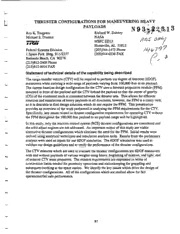
NASA Technical Reports Server (NTRS) 19930013124: Thruster configurations for maneuvering heavy payloads PDF
Preview NASA Technical Reports Server (NTRS) 19930013124: Thruster configurations for maneuvering heavy payloads
L THRUSTER CONFIGURATIONS FOR _UVERING HEAVY | PAYLOADS " N 9 3 Roy K. Tsugawa Richard W. Dabney Michael E. Draznin NASA _mnqlmml MSFC ED13 • •gl_ Huntsville, AL 35812 Federal Systems Division (205)544-1473 Phone 1 Space Park Bldg. Rll/2337 (205)544-0236 FAX Redondo Beach, CA 90278 (213)812-2608 Phone (213)812-8016 FAX Statement of technical details of the capability being described The cargo transfer vehicle (CTV) will be required to perform six degree of freedom (6DOF) maneuvers while carrying a wide range of payloads varying from 100,000 Ibm to no payload. The current baseline design configuration for the CTV uses a forward propulsion module (FPM) mounted in front of the payload and the CTV behind the payload so that the center of gravity (CG) of the combined stack is contained between the thruster sets. This allows for efficient rotations and translations of heavy payloads in all directions; however, the FPM is a costly item, so it is desirable to find design solutions which do not require the FPM. This presentation provides an overview of the work performed in analyzing the FPM requirements for the CI'V. Specifically, key issues related to thruster configuration requirements for operating CTV without the FPM throughout the 100,000 Ibm payload to no payload range will be highlighted. In this study, only the reaction control system (RCS) thruster configurations are considered and the orbit adjust engines are not addressed. An important output of this study are viable alternative thruster configurations which eliminate the need for the FPM. Initial results were m derived using analytical techniques and simulation analysis tools. Results from the preliminary analysis were used as inputs for our 6DOF simulation. The 6DOF simulation was used to validate our design guidelines and to verify the performance of the thruster configurations. The crv missions which are used to evaluate the thruster configurations are 6DOF maneuvers with and without payloads of various weights using heavy, beginning of mission, and light, end of mission CTV mass properties. The mission requirements are expressed in terms of acceleration limits needed for proximity operations and stationkeeping for grappling and subsequent berthing at the space station. We identify the key issues which drive the design of u the thruster configurations. All of the configurations which are studied allow for fail operational/fail safe performance. 87 History of the origins and evolution of the capability IB TRW has worked extensively on the problem of 6DOF maneuvering with a heavy payload. _itial Work Was perfo_ed during the orbital maneuvering vehicle (0_ contract and later I work was performed during the Shuttle-C study. I | The level of maturity of the capability -_=_ .. _ The guidelines for vehicle control authority requirements have been established and the analytical tools for studying different control configurations are in use. We have the capability | of generating thruster configurations and jet select tables and control loop gains to test different design configurations. | Test experience and/or experimental results The baseline CTV configuration has been implemented in the 6DOF simulator and we have produced simulation results which validate the analytical predictions. From these simulations, performance characteristics of the thruster configurations with different payloads have been derived. Results show that heavy payload operation is possible with the CTV alone (without the FPM') if attention is paid to the maximum and minimum torque requirements. : | Source/sponsorship and current funding estimates i The current heavy payload thruster configuration studies are being funded through the study contract. Pastefforts have been funded by TRW [P,.AD. i m I B D [i I i [] II g II U 87-1 m []
